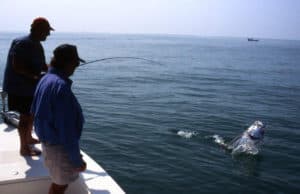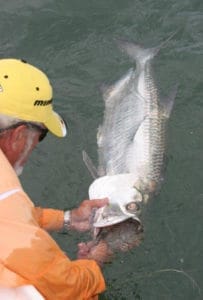by Bob McNally
Every serious angler deserves to catch at least one tarpon in his or her life. One tarpon likely won’t be their last, however, because anglers will be hooked forever in chasing what many believe is the greatest light-tackle gamefish on earth.

To battle a tarpon is the dream of many anglers. These amazing, acrobatic fish put on a quite a show.
The dream of many anglers is to battle a tarpon. Here’s why, how, where, and some professionals who can help make this dream a reality.
Prime time for a tarpon is late spring through summer. It’s a season when acre-size schools of 100-pound fish roll at the surface, reflecting sunlight helter-skelter off hundreds of fist-size silver scales. It’s when a 150-pound prehistoric-like fish inhales bass-size plugs and streamer flies, then explodes at the hook set. It’s when a 6-foot long, twisting and spinning mass of chrome muscle and bone soars in cartwheels 10 feet above the horizon.
Few gamefish grow as large, fight as strong, leap as high, and readily strike lures and baits as do tarpon. Commonly weighing 100 pounds, with fish caught annually over 200 pounds, the coastal-living tarpon is revered worldwide, and offers southeast coastal anglers exceptional fishing opportunities.
Tarpon are found in large numbers along both the Southeast Atlantic and Gulf Coasts, with the very best fishing found from middle Georgia to the Florida Keys, and up the Florida Gulf Coast to Alabama.
Tarpon fishing is mostly summer fishing, with peak action in June during the famed “migration” that starts in the Florida Keys, and spreads north and west as the weather and water warms.

Tarpon fishing is a catch-and-release sport. Even just having a tarpon hit, called a “jump,” is seen as success by die-hard tarpon hunters.
Excellent summer-through-fall tarpon action is found throughout the coastal waters of Florida. However, tarpon numbers dwindle during summer on Keys flats. The big push of spring fish in famed places like Boca Grande Pass at the mouth of Charlotte Harbor near Fort Myers also diminishes by summer. But there still are tarpon about, and they suddenly can show almost anywhere—even in freshwater rivers feeding bays, sounds and estuaries. More than one coastal river largemouth bass fisherman has been shocked when he set the hook, only to see an 80-pound tarpon go airborne like a silver submarine-fired missile.
Many anglers measure success by the number of tarpon they “jump,” not necessarily land. Tarpon have rock-hard mouths, so setting a hook in one is difficult. Thus, to “jump” fish is tantamount to success, since on average one tarpon is caught per five or six “jumped.” Further, battling a 100-pound tarpon on even 30-pound test plug tackle is rough sport, often lasting an hour or more. Only the toughest angler can handle “catching” several such tarpon in a day.
Stu Apte is a tarpon fishing legend, who while in his 80s still fishes religiously for tarpon in his native Florida, especially in the Keys, where he lives.
“I’ve always liked strong spring tides for tarpon because it concentrates fish and makes them feed more on tidbits carried with current,” Stu said. “I like fishing the day before the new and full moon, and three days thereafter on each moon, which offers five choice days of strong tides, or 10 days of great tarpon fishing per month. I’ve kept a daily log of my tarpon fishing for many years, and there is no question these tide phases have been best for me.”
Clear-water tarpon fishing is a classic flats venue, especially casting to visible fish. But Stu Apte loves working slightly discolored water, so-called “trout” or “mullet muds,” because tarpon are not able to scrutinize a lure as well, and so they strike more readily. This, too, is one plus for night tarpon fishing, which is popular and productive in many areas, especially in metropolitan areas of south Florida around Miami, Fort Lauderdale, Tampa and Fort Myers.
Stu prefers comparatively small tarpon lures, like streamers tied on 1/0 hooks and measuring just 1 1/2 inches long. Bigger flies and lures are best in murky or dark water, he says. Lure color is important, too, with very pale lures in pearl, white and yellow in clear water over light sand bottoms. Darker, larger lures are best in dark water and areas with grass or colored bottom.
“Lots of artificials account for tarpon,” he said. “Some of my favorites include MirrOlures, especially the 77M and 72M models; Bagley Finger Mullet and Pinfish also have accounted for plenty of tarpon, as have DOA Shrimp artificials.
“Don’t forget natural baits, they can be deadly for tarpon,” Stu said. “You should fish whatever tarpon are eating. It may be crabs or pinfish or mullet. Live big shrimp also are one of the best tarpon baits going.”
The industry that targets tarpon in Florida is worth nearly $2 billion per year. Regionally, from the Carolinas to Texas, where tarpon are also caught, it’s a $5 to 6 billion per year business.
Some of the best tarpon professionals fishing in some of the most choice Florida locations for this great fish include the following:
Capt. Phil Chapman, Homosassa, [email protected]; 863-640-7461.
Capt. Kevin Faver, St. Augustine, www.outdoorsshow.com; 904-669-6251; [email protected].
Capt. Tommy Locke, Boca Grande, www.capttommylocke.com; 941-964-0083; [email protected].
Capt. Dave Markett, Tampa, [email protected]; This e-mail address is being protected from spambots. You need JavaScript enabled to view it; 813-927-3474.
Capt. Bill Miller, 813-363-9926; www.billmiller.com; bill[email protected].
Capt. Phil O’Bannon, Boca Grande, www.obannonscharter.com; 941-964-0359; [email protected].
Capt. Bouncer Smith, Miami, www.captbouncer.com; 305-439-2475; [email protected].
Capt. Earle Waters, Homosassa, www.homosassa-flyfishing.com; 352-302-0359; [email protected].
The Union Sportsmen’s Alliance website is designed to provide valuable articles about hunting, fishing and conservation for members of AFL-CIO affiliated labor unions and all sportsmen and sportswomen who appreciate hunting and fishing and want to preserve our outdoor heritage for future generations. If you would like your own story and experience from the outdoors to be considered for our website, please email us at [email protected].




